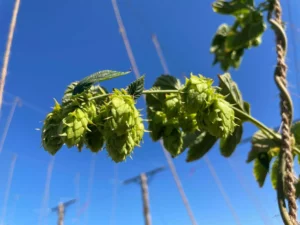Hop cones (pictured above) give beer its smell and flavor. The biggest producers of hops in the U.S. are Washington, Oregon and Idaho, but researchers and farmers are looking for ways to grow the crop in the Midwest. Photo by Markus Spiske Unsplash.com
Xcaret Nuñez
Harvest Public Media
The craft beer industry is driving farmers in the Midwest to grow hops for their local beer makers. But the crop is not easy to grow — it’s labor intensive and expensive.
For the past 10 years, craft beer breweries have popped up all over the country, and some Midwest farmers are responding to the local craft beer craze by growing their own hops.
In the U.S. nearly all hop production takes place in the Pacific Northwest, with 70-75% of the crop grown in Yakima, Washington, where it’s often irrigated. The crop thrives in a moist temperate climate with long sunny days. Yet while a lot fewer acres of hops are grown in Midwestern states, (Continued on page 20)
(HOPS Continued from page 1) farmers and researchers are trying to change that.
Katie Stenmark is a horticulture doctoral student at Oklahoma State University and is one of three hop growers in Oklahoma. She’s currently researching how well different hop varieties will grow in both a greenhouse and on a quarter of an acre field environment.
“Oklahoma has ample access to wheat and barley for making beer, but we don’t have access to hops,” Stenmark said. “The overall goal of this project is to create quality hop cones that we can then use for a local brewery to create an Oklahoma-grown beer.”
Stenmark said her three-year study on growing hops will eventually help make recommendations to farmers interested in growing it in Oklahoma, where there’s currently less than an acre of the crop. Universities in Nebraska, Iowa and Missouri have also invested in research into growing the specialty crop.
More than 85% of Americans live within ten miles of a brewery, according to the Brewers Association, a trade organization of small and independent brewers. Although the latest hops production report from the U.S. Department of Agriculture shows total acreage was down by 2%, it doesn’t get the whole picture — it only records data for Washington, Oregon and Idaho, the three major hops producers.
“Since craft beer consumes so many hops, it’s really spiked a demand for this commodity,” said Maggie Elliott, science and communications director for Hop Growers of America. “Growers in the Midwest are engineering adaptive ways to embrace different challenges.”
Ryan Triggs, a Kansas hop grower and co-owner of Kansas Hop Company, has been learning how to adapt to the state’s heavy soil and daylight conditions since 2016. His familiarity with the craft beer scene and marrying into an agricultural family sparked his interest in growing hops. But he said it’s taken a lot of work to get to where he is now.
“We sold all our hops to four different breweries in our first year,” Triggs said. “But we had about 20 people on the field handpicking hop cones in the August heat — it was miserable. We realized quickly that we never wanted to handpick again.”
While the average size of a hop yard in the Pacific Northwest is 800 acres, Triggs grows hops on 3 acres — and his farm makes up about 30% of Kansas’ hops acreage. Triggs sells hops to about 75 breweries across the Midwest and opened a taproom called Tall Trellis in Olathe, Kansas, earlier this year.
But growing hops on a commercial scale is labor intensive and expensive. Adapting to a region’s challenges, like installing LED grow lights and an irrigation system, is a financial investment for farmers. It also requires setting up 18-foot trellises with coir twine every year for the hop bines, or long stems, to grow on.
“So far, there’s been no way to mechanize how to string the hops,” Elliot said. “Sometimes people have to even train the hops to grow and have to wind twine around every single plant.”
According to researchers at Michigan State University, it costs nearly $14,000 for a farmer to establish a hop yard the size of an acre. Then it takes about three years for hop plants to mature and produce a good yield.
Hops farmers are exploring how the climate and the soil the crop is grown in affect its flavor, similar to wine grapes. Triggs said having a unique flavor will make a grower’s hops stand out from the rest.
“It’s like having a brand-new color for an artist that they’ve never had before when they’re trying to paint a picture,” he said. “So giving a brewer an ingredient that they haven’t had access to before, opens up some doors as far as making new beers that can’t be released anywhere else.”
As for Stenmark, the Oklahoma State researcher, she looks forward to discovering how locally grown hops will influence local brews.
“We’re not necessarily expecting the same flavor profile as something that would be produced in the Pacific Northwest,” Stenmark said. “But we’re interested in finding out Oklahoma’s flavor of beer.”
https://www.kcur.org/news/2022-09-22/midwest-farmers-hope-their-hops-can-add-a-distinctive-flavor-to-your-craft-beer



